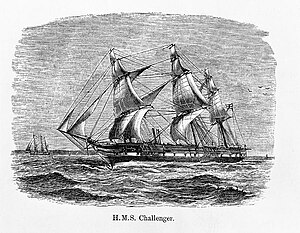HMS Challenger (1858): Difference between revisions
replacing image using AWB |
GrahamBould (talk | contribs) Added another etching of Challenger, during expedition |
||
| Line 39: | Line 39: | ||
To enable her to probe the depths, the ''Challenger's'' guns had been removed and her spars reduced to make more space available. Laboratories, extra cabins and a special dredging platform were installed. She was loaded with specimen jars, [[alcohol]] for preservation of samples, [[microscope]]s and chemical apparatus, [[trawl]]s and [[dredge]]s, [[thermometer]]s and water sampling bottles, sounding leads and devices to collect [[sediment]] from the sea bed and great lengths of rope with which to suspend the equipment into the ocean depths. In all she was supplied with 181 miles (290 km or 335 km?)<!--depends if nautical miles or statute miles; with the odd, three "significant" digit number, it may well be 1,100,000 feet expressed in nautical miles)--> of Italian [[hemp]] for sounding, trawling and dredging. |
To enable her to probe the depths, the ''Challenger's'' guns had been removed and her spars reduced to make more space available. Laboratories, extra cabins and a special dredging platform were installed. She was loaded with specimen jars, [[alcohol]] for preservation of samples, [[microscope]]s and chemical apparatus, [[trawl]]s and [[dredge]]s, [[thermometer]]s and water sampling bottles, sounding leads and devices to collect [[sediment]] from the sea bed and great lengths of rope with which to suspend the equipment into the ocean depths. In all she was supplied with 181 miles (290 km or 335 km?)<!--depends if nautical miles or statute miles; with the odd, three "significant" digit number, it may well be 1,100,000 feet expressed in nautical miles)--> of Italian [[hemp]] for sounding, trawling and dredging. |
||
The ''Challenger'' carried a [[complement]] of 243 officers, scientists and crew when she embarked on her 68,890 nautical mile (127,670 km) journey. |
The ''Challenger'' carried a [[complement]] of 243 officers, scientists and crew when she embarked on her 68,890 nautical mile (127,670 km) journey.[[Image:HMS Challenger (1858).jpg|thumb|left|350px|HMS Challenger during the 'Challenger expedition' 1873-76.]] |
||
Despite the great success of the Challenger Expedition, the ''Challenger'' suffered an ignominious fate. She was commissioned as a [[Coast Guard]] and [[Royal Naval Reserve]] training ship at [[Harwich]] in July 1876. She was finally paid off at the [[Chatham Dockyard]]s in 1878. She remained in reserve until 1883, when she was converted into a receiving hulk in the [[River Medway]], where she stayed until she was finally broken up for her [[copper]] bottom in 1921. Nothing, apart from her [[figurehead]], now remains. This is on display in the foyer of [[Southampton]] Oceanography Centre. The [[Space Shuttle Challenger|Space Shuttle ''Challenger'']] was named after the ship[http://www-pao.ksc.nasa.gov/shuttle/resources/orbiters/Challenger.html]. |
Despite the great success of the Challenger Expedition, the ''Challenger'' suffered an ignominious fate. She was commissioned as a [[Coast Guard]] and [[Royal Naval Reserve]] training ship at [[Harwich]] in July 1876. She was finally paid off at the [[Chatham Dockyard]]s in 1878. She remained in reserve until 1883, when she was converted into a receiving hulk in the [[River Medway]], where she stayed until she was finally broken up for her [[copper]] bottom in 1921. Nothing, apart from her [[figurehead]], now remains. This is on display in the foyer of [[Southampton]] Oceanography Centre. The [[Space Shuttle Challenger|Space Shuttle ''Challenger'']] was named after the ship[http://www-pao.ksc.nasa.gov/shuttle/resources/orbiters/Challenger.html]. |
||
See [[HMS Challenger|HMS ''Challenger'']] for other ships of the same name. |
See [[HMS Challenger|HMS ''Challenger'']] for other ships of the same name. |
||
[[Category:Research vessels]] |
[[Category:Research vessels]] |
||
Revision as of 21:16, 15 June 2006

| |
| Career | |
|---|---|
| Launched: | 1858 |
| Decommissioned: | Chatham Dockyard, 1878 |
| Fate: | Broken for scrap, 1921 |
| General Characteristics | |
| Displacement: | 2306 tons (2343 t) |
| Length: | 200 ft (61 m) |
| Propulsion: | Steam (1200 hp or 900 kW) and sail |
| Range: | 68,890 nautical miles (127,670 km) (see article) |
| Complement: | 243 |
| Armament: | 17 guns (all but 2 were removed) |
The fifth HMS Challenger (launched 1858) was a steam assisted British naval corvette. In 1862 she took part in operations against Mexico, including the occupation of Vera Cruz, and in 1866 a punitive operation against some Fijian natives to avenge the murder of a missionary and some of his dependents. Despite this less than glorious history, this vessel is notable for carrying the first global marine research expedition, the Challenger expedition.
To enable her to probe the depths, the Challenger's guns had been removed and her spars reduced to make more space available. Laboratories, extra cabins and a special dredging platform were installed. She was loaded with specimen jars, alcohol for preservation of samples, microscopes and chemical apparatus, trawls and dredges, thermometers and water sampling bottles, sounding leads and devices to collect sediment from the sea bed and great lengths of rope with which to suspend the equipment into the ocean depths. In all she was supplied with 181 miles (290 km or 335 km?) of Italian hemp for sounding, trawling and dredging.
The Challenger carried a complement of 243 officers, scientists and crew when she embarked on her 68,890 nautical mile (127,670 km) journey.

Despite the great success of the Challenger Expedition, the Challenger suffered an ignominious fate. She was commissioned as a Coast Guard and Royal Naval Reserve training ship at Harwich in July 1876. She was finally paid off at the Chatham Dockyards in 1878. She remained in reserve until 1883, when she was converted into a receiving hulk in the River Medway, where she stayed until she was finally broken up for her copper bottom in 1921. Nothing, apart from her figurehead, now remains. This is on display in the foyer of Southampton Oceanography Centre. The Space Shuttle Challenger was named after the ship[1].
See HMS Challenger for other ships of the same name.
